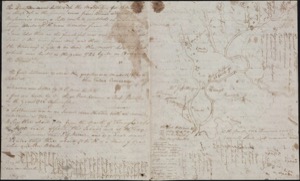January 3, 1804
[Clark]
Tuesday Jany 3rd 1804 a Verry Cold blustering day 〈the Merkery?〉 in Doneyan [1] Co: Thermometer one oClock in the open air the 〈quick-silver〉 mercuria fell to 21 D. below the freezing point [11° F], I took the altitude of the suns L. L. and made it 57° 16 0 N by the Sexton, all the after part of the Day the wind so high that the View up the Missouris appeared Dredfull, as the wind blew off the Sand with fury as to Almost darken that part of the atmespear this added to agutation of the water apd. truly gloomy Comy [commissary] Kiled a Beef &
at 3 oClock the q s or murcy. fell to 22 D. below feesing [10° F.]
| at 4 | do— do— do | 27 ½ ditto [4 ½° F.] | in the air |
| at 5 | do— do— do | 30 or (O) |
the wind violent all Day from N. N W. & N W. [2]
3d Jany 1804 Excessive Cold after Sunset
ca. January 3, 1804, Field Notes, reverse of document 4



